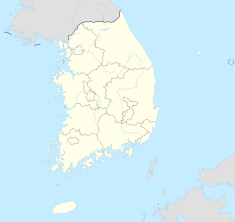Seonjeongneung
| Seolleung and Jeongneung | |
|---|---|
 Jeongneung, the tomb of King Jungjong, at the Seonjeongneung site | |
| Location | Seoul, South Korea |
| Coordinates | 37°30′32″N 127°02′57″E / 37.50889°N 127.04917°ECoordinates: 37°30′32″N 127°02′57″E / 37.50889°N 127.04917°E |
| Governing body | Cultural Heritage Administration of Korea |
| Type | Cultural |
| Criteria | iii, iv, vi |
| Designated | 2009 (33rd session) |
| Reference no. | 1319 |
| State Party | |
| Region | Asia and Australasia |
 Seolleung and Jeongneung in Seoul, South Korea | |
| Seonjeongneung | |
| Hangul | 선정릉 |
|---|---|
| Hanja | |
| Revised Romanization | Seonjeongneung |
| McCune–Reischauer | Sŏnchŏngnŭng |
The Seonjeongneung is the burial grounds of two Joseon Dynasty kings and one Joseon queen. The westernmost tomb belongs to King Seongjong (r. 1469–1494), the ninth king of the Joseon dynasty.[1] His first wife, Queen Han, died at age 18 and is buried near Munsan, north of Seoul. His second wife, Queen Jeonghyeon (貞顯王后, 1462–1530), from the Yun family, is buried here because she gave birth to the king's second son (the future King Jungjong) in 1506.[2] Queen Jeonghyeon outlived her husband by 35 years and was buried in a splendid tomb to the east of her husband. Her grave has a stone fence encircling the mound, whereas her husband's tomb, on the left, has a retaining wall as well. Statues of civilian and military officials and their horses stand at attention in front of the graves. South of the tombs is a single T-shaped shrine of the type commonly found at Joseon-era royal tombs. There are also several ancillary buildings for storing material used in sacrifices.
Queen Jeonghyeon had a deep interest in Buddhism and founded the nearby temple Bongeunsa.
The other tomb on the site is Jeongneung tomb, located at the easternmost part of the site. This is the burial ground of King Jungjong, the 11th king of Joseon (r. 1506–1544). He was a son of Seongjong, and was originally buried at Goyang near Munsan, north of Seoul. However, his third queen thought it would be better to have him re-interred closer to his father. She expressed a wish to be buried alongside him, but this wish was never carried out, and his tomb stands alone.
Japanese invasions of Korea and Seonjeongneung[]
As Seolleung and Jeongneung were excavated during the Japanese invasions of Korea during the Joseon Dynasty, the bodies of both Seongneung and Jeongneung were not found in the three tombs. Jeongneung is more unusual as only the ashes were found in the tombs of King Seongjong and Queen Junghyeon, but the bodies of the deceased in Jungjong were found. To determine whether or not this corpse belonged to King Jungjong, they conducted a survey from the elder to the heads of the court. Few people remembered his appearance because he had died a long time ago, and it was difficult to confirm the fact that the rest of them were aged too. The records and the dead body were very different. And it was in the hot summer when Jungjong died, but the fact that the body was still intact. Some questions have been raised as to whether the Japanese army had kept the tomb for the sake of the deceased. People could not easily come to a conclusion because it might have been Jungjong's body. Eventually, Seonjo ordered the body to be buried somewhere else.[3]
See also[]
| Wikimedia Commons has media related to Seonjeongneung. |
References[]
- ^ "Seonjeongneung". Cultural Heritage Administration. Retrieved 2008-04-21.
- ^ "Cultural Heritage Administration". Retrieved 2010-11-06.
- ^ 선조실록 40권, 26년(1593 계사 / 명 만력(萬曆) 21년)7월 7일(기미) 3번째기사 http://sillok.history.go.kr/inspection/insp_king.jsp?id=kna_12607007_003
External links[]
- Gangnam District
- Royal Tombs of the Joseon Dynasty
